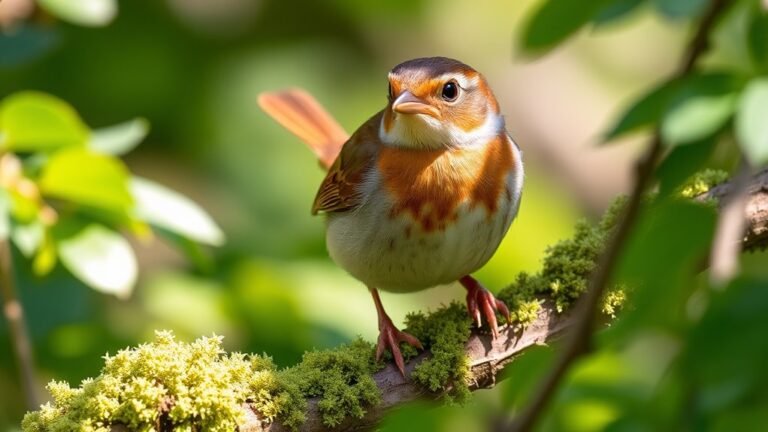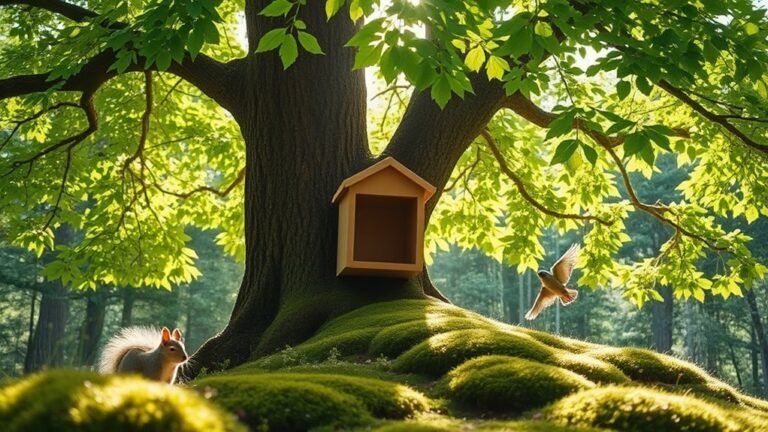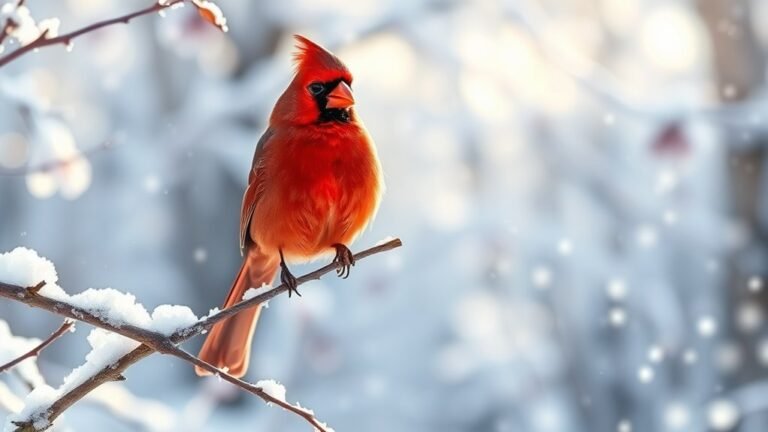Bird Sounds Like an Owl: Decoding Nocturnal Calls
As you explore the night, you may hear sounds that imitate the calls of owls. These sounds can be misleading and may differ in tone and rhythm from actual owl calls. By observing these differences, you can learn more about the birds making these sounds. Recognizing these variations is important, as they provide insight into the birds' roles in their environment and their behaviors. What can these mimicry patterns tell us about nighttime ecosystems?
Key Takeaways
Owls produce unique hooting sounds that set them apart from birds that mimic sounds, such as Eastern Whip-poor-wills and mockingbirds. Listening closely to the pitch and rhythm of these sounds can help distinguish real owl calls from imitations. Other birds mimic calls to keep predators away or to strengthen social ties within their species. The type of habitat influences how birds vocalize, with rich environments supporting a variety of bird calls. Habitat loss and noise pollution can disrupt birds' communication, which can harm their populations and the roles they play in ecosystems.
The Allure of Owl Sounds in Nature

Few sounds capture our attention like the calls of owls that echo during the night.
These nighttime sounds play an important role in nature, creating a unique experience for those who explore the dark woods. As you listen, you'll notice how their calls blend into the night, each hoot and screech serving a clear purpose.
Owls use their sounds to mark their territory, attract mates, and find each other in the wild. This communication enriches your connection to nature, giving you a sense of belonging as you tune into the patterns of wildlife.
Embracing these sounds can deepen your appreciation for the vibrant lives that unfold after sunset.
Common Birds That Mimic Owl Calls
To tell apart an owl's real call from birds that mimic, listen carefully. The Eastern Whip-poor-will and mockingbirds can sound like owls with their calls. The Eastern Whip-poor-will makes repeated sounds that can echo owl calls, especially at night.
Mockingbirds are skilled at imitating many bird calls, including owls.
When you hear these sounds, notice the differences in pitch and rhythm. Owl calls often have a clear hooting pattern that imitators don't fully copy.
Understanding the Purpose of Mimicry

Mimicry in birds serves important ecological and social roles that help them adapt. When birds imitate the calls of other species, they gain several advantages for survival.
Here are three key aspects:
- Avoiding Predators: Some birds mimic owl calls to scare off potential threats and protect themselves.
- Building Social Connections: By imitating the calls of local species, birds create social bonds and fit into their surroundings.
- Claiming Territory: Mimicking the calls of stronger species can help birds secure their territory by making rivals leave.
These strategies show that mimicry is a vital skill for survival in bird life.
Understanding these behaviors enhances our appreciation for these fascinating creatures.
The Role of Habitat in Vocalization
Bird vocalizations change based on their habitats. These environments shape the sounds birds make and how they communicate.
In rich habitats like dense forests or wetlands, you'll hear diverse calls. This variety encourages birds to adapt their songs to be heard over background noises like rustling leaves or flowing water. For example, birds in open fields often use loud, simple calls.
In contrast, species in dense brush may create more intricate sounds to hide their presence. Understanding how habitat influences vocalization helps you appreciate bird communication and connect with nature.
Recognizing the Difference: Owls vs. Mimics

To distinguish between the calls of owls and mimic birds at night, consider these key points:
- Tone and Rhythm: Owls make deep hoots that are steady. Mimics have varied tempos in their calls.
- Repetition: An owl's call is clear and consistent. Mimics repeat their sounds with changes and longer calls.
- Behavior in Context: Owls are often alone in quiet areas. Mimics tend to call in groups.
By paying attention to these details, you can better identify the sounds and behaviors of owls and mimics in your environment.
Enjoy the experience of exploring bird calls at night!
Top Owls and Their Distinctive Calls
Owls make a variety of calls that show their specific roles in the night ecosystem. Each species of owl has different sounds. For example, the Great Horned Owl has deep hoots, while the Barn Owl is known for being silent.
The Barred Owl's calls can sound sad, suggesting they long for something, while the Screech Owl makes sharp sounds to warn others of danger. Listening to these calls helps you learn more about these amazing birds.
Their sounds create a rich form of communication, showing their social interactions and ecological roles. Engaging with owl calls can also help you connect with other bird lovers.
The Impact of Seasonality on Bird Sounds
As seasons change, bird sounds also change. This reflects shifts in their environment and survival methods. Throughout the year, you can hear different bird vocalizations linked to migration and breeding.
Here are some key points to consider:
- Breeding Season: During this time, birds increase their calls. These sounds help establish territories and attract mates.
- Migration: Birds make specific calls to communicate with their flock while traveling long distances.
- Wintering: In winter, fewer birds call. Some species leave for warmer areas, while others change their sounds to adapt to the cold.
Listening to bird sounds can offer insight into their behaviors and seasonal changes.
Conservation and the Importance of Bird Communication
Bird communication is vital for their survival and plays a key role in conservation. Birds use calls and songs for mating, establishing territories, and avoiding predators.
Habitat loss and noise pollution disrupt these communications, leading to fewer offspring and greater risks from predators. Understanding bird vocalizations helps conservationists evaluate bird populations and their environments.
Creating safe spaces for birds allows them to communicate better. Getting involved in local conservation activities connects you with others who care about bird welfare. Together, you can help protect the intricate connections that depend on bird communication.
Tips for Listening to Nocturnal Birds
Listening to nocturnal birds offers a unique insight into bird communication.
To improve your experience, follow these simple tips:
- Choose a Quiet Spot: Find a peaceful area away from city sounds. This will help you hear the birds better.
- Pick the Best Time: Listen just after sunset or before dawn. These times have the most bird activity.
- Use Good Equipment: Get quality headphones and a recording device. This allows you to hear and study the bird calls later.
Enjoy the sounds of the night and the fascinating calls of nocturnal birds.
Frequently Asked Questions
Can Birds Other Than Owls Produce Similar Sounds?
Yes, some birds, like nightjars and certain hawks, can make sounds similar to owls. Their calls have similar tones, adding to the sounds you hear at night. This variety enhances the atmosphere of nighttime environments.
How Do Different Environments Affect Bird Calls?
Different environments affect bird calls in specific ways. In urban areas, noise pollution makes it hard for birds to communicate. In contrast, forests create a clear sound landscape, allowing birds to convey their messages more effectively. This clarity helps listeners enjoy the diversity of bird calls in various habitats. Understanding these differences enhances our appreciation for avian communication.
Do Certain Birds Mimic Owl Calls for Protection?
Some birds mimic owl calls to protect themselves from predators. This behavior helps them scare off threats. By imitating owls, these birds enhance their chances of survival in the wild. It shows how different species adapt to avoid danger.
What Time of Year Are Owl Sounds Most Prominent?
Owl sounds are most common during the fall migration and breeding season. As these times approach, you can hear their calls in the night. These sounds indicate their territory and attract mates, creating a captivating nighttime chorus.
Are There Any Cultural Beliefs Associated With Owl Sounds?
Owl folklore differs across cultures. Many cultures view owls as symbols of wisdom, death, or change. Their sounds carry significant meaning and invite people to explore the beliefs associated with them. You can find stories and interpretations in various traditions, reflecting diverse perspectives on these fascinating creatures.

Ava is a bird enthusiast and nature lover who has spent countless hours observing and learning about the fascinating world of birds. With a passion for sharing her knowledge and inspiring others to appreciate the beauty of birds, Ava writes about her experiences and insights on avianadmirer.com.







